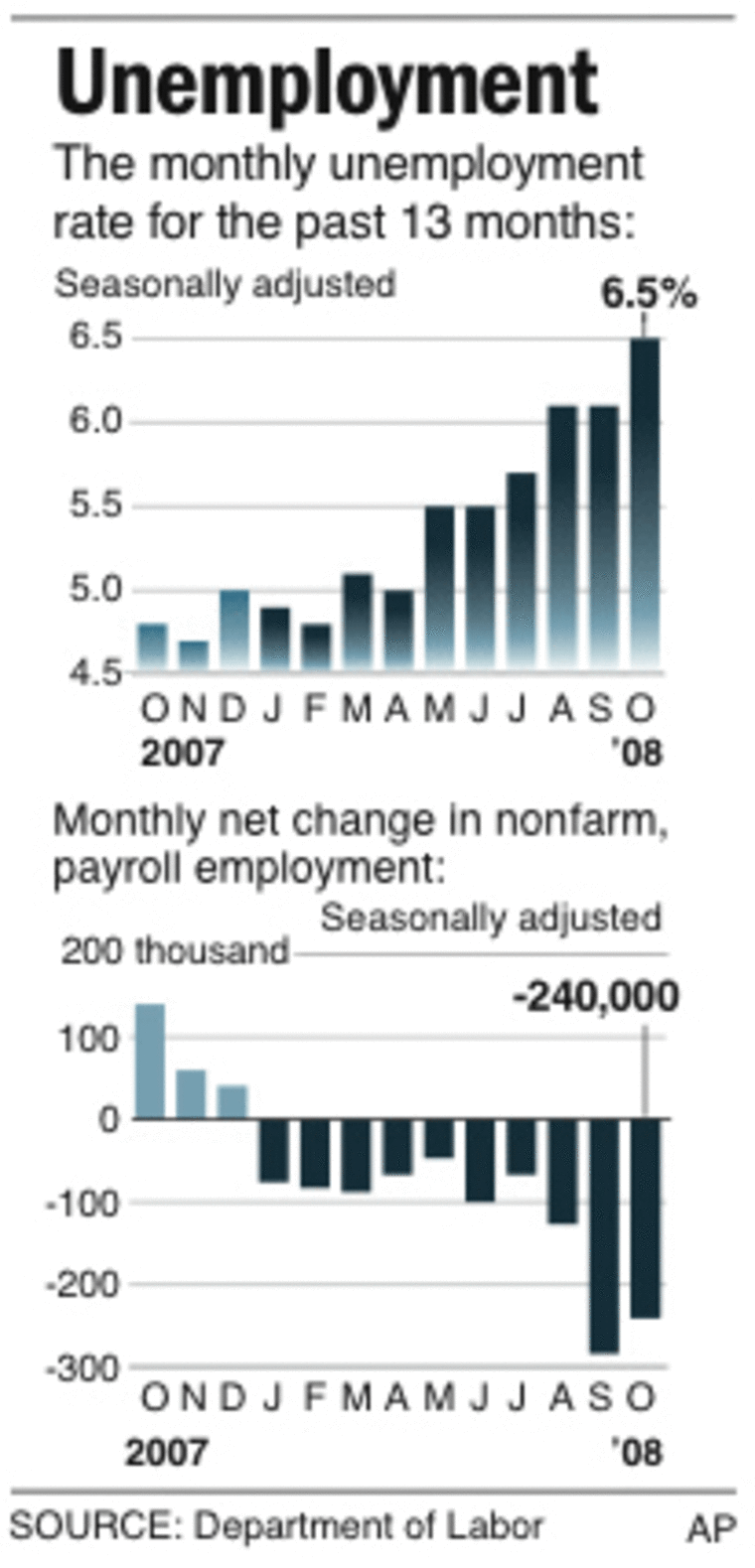The nation’s unemployment rate bolted to a 14-year high of 6.5 percent in October as another 240,000 jobs were cut, far worse than economists expected and stark proof the economy is deteriorating at an alarmingly rapid pace.
The new snapshot, released Friday by the Labor Department, showed the crucial jobs market quickly eroding. The jobless rate zoomed to 6.5 percent in October from 6.1 percent in September, matching the rate in March 1994.
Unemployment has now surpassed the high seen after the last recession in 2001. The jobless rate peaked at 6.3 percent in June 2003.
October’s decline marked the 10th straight month of payroll reductions, and government revisions showed that job losses in August and September turned out to be much deeper. Employers cut 127,000 positions in August, compared with 73,000 previously reported. A whopping 284,000 jobs were axed in September, compared with the 159,000 jobs first reported.
So far this year, a staggering 1.2 million jobs have disappeared. Over half the decrease occurred in the past three months alone.
The unemployment report was worse than expected, and was accompanied by more bad news from the auto sector.
Ford Motor Co. reported dismal third-quarter results and announced plans to cut more than 2,000 additional white-collar jobs, and General Motors said it lost $2.5 billion in the third quarter and could run out of cash in 2009.
Yet Wall Street investors appeared to take it in stride. The Dow Jones industrial average was up sharply after steep losses in the previous two sessions.
About 10.1 million people were unemployed in October, an increase of 2.8 million over the past year. A year ago, the unemployment rate stood at 4.8 percent.
President Bush said the dismal employment figures reflect “the difficult challenges confronting the economy” and urged the country to have patience, saying a flurry of unprecedented government measures — including a $700 billion financial bailout package — will take time to work.
“I understand that Americans deeply concerned about the challenges facing our economy, but our economy has overcome great challenges before, and we can be confident that it will do so again,” Bush said.
The employment market is much weaker than economists expected. They were forecasting the unemployment rate to climb to 6.3 percent in October and for payrolls to fall by around 200,000.
“The U.S. recession is deepening,” said Michael Gregory, economist at BMO Capital Markets Economics. The final quarter of this year is getting off to a “particularly ugly” start, he said.
Job losses were widespread, reflecting the mounting carnage from a trio of crises — housing, credit and financial.
Factories cut 90,000 jobs, the most since July 2003. Construction companies got rid of 49,000 jobs with heavy losses in home building. Retailers cut payrolls by 38,000. Professional and business services reduced employment by 45,000. Financial activities cut 24,000 jobs, with heavy losses in mortgage banking and at securities firms. Leisure and hospitality axed 16,000 positions.
All those losses more than swamped some gains elsewhere, including in the government, as well as in education and health care.

Racing to assemble his new Democratic Cabinet, President-elect Barack Obama was scheduled to huddle with economic advisers Friday. His team has been in close contact with the Bush administration to pave the way for a smooth hand-off of power.
All the economy’s woes — a housing collapse, mounting foreclosures, hard-to-get credit and financial market upheaval — will confront Obama when he assumes office early next year. And, the employment situation is likely to get worse.
Many expect the jobless rate to climb to 8 percent, possibly higher, next year. In the 1980-1982 recession, the unemployment rate rose as high as 10.8 percent before inching down.
The grim numbers spurred calls from Democrats on Capitol Hill to provide fresh relief. House Speaker Nancy Pelosi said Democrats, in a lame-duck session later this month, will push to enact another round of economic stimulus of around $100 billion, possibly including provisions to create jobs through big public works projects.
White House press secretary Dana Perino appeared to suggest that additional action may not be needed.
“Today’s employment numbers are a stark reminder of how critical it is we keep focused on utilizing the tools we now have to return our country to the strong job creation we had in recent years,” Perino said. “We know what the main problems are tight credit and housing markets and we have the tools to solve them.”
The economy has lost its footing in just a few months. It contracted at a 0.3 percent pace in the July-September quarter, signaling the onset of a likely recession. It was the worst showing since 2001 recession, and reflected a massive pullback by consumers.
As U.S. consumers watch jobs disappear, they’ll probably retrench even further, spelling more trouble for the sinking economy.
That’s why analysts predict the economy is still shrinking in the current October-December quarter and will contract further in the first quarter of next year. All that more than fulfills a classic definition of a recession: two straight quarters of contracting economic activity.